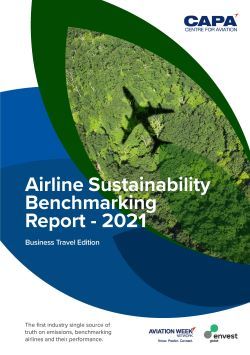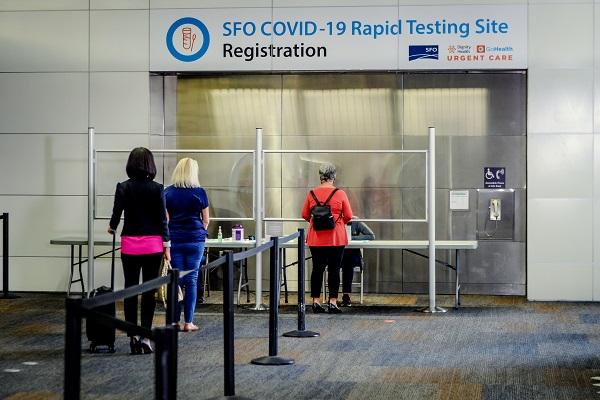CAPA, Envest Global Benchmark Airline Sustainability for Corporate Buyers
Building on the joint CAPA-Envest Airline Sustainability Benchmarking Report released last fall through CAPA that was geared toward airlines and the investment community, the companies have teamed up again to create a new airline sustainability benchmarking report directed at...

Procurement Disclosure: BTN is acting as the exclusive distribution partner of this report to the corporate travel industry; BTN has a commercial interest in sales of this report.
Get This Report
The CAPA, Envest Global Airline Sustainability Benchmarking Report compares 52 airlines on their sustainability performance based on 2019 data. This is not a free resource. It may be purchased here.
Building on the joint CAPA-Envest Airline Sustainability Benchmarking Report released last fall through CAPA that was geared toward airlines and the investment community, the companies have teamed up again to create a new airline sustainability benchmarking report directed at corporate buyers.
The report provides recommendations for how corporate buyers can put together a customized approach for assessing an airline's sustainability. It also includes an analysis of publicly reported sustainability information and strategies from 2019-2020 on 52 carriers, including the 20 largest operators by revenue and seat capacity in 2019, their most recent Carbon Disclosure Project score, alignment with the Science Based Target initiative.
"The airlines will be made aware [of the report]," said Envest strategic advisor Johnny Thorsen, who also is VP of strategy and partnerships for the recently launched travel management company Spotnana. "I have tested the waters with a few airlines, and they may react defensively. We expect that, because the airlines are not used to being called out on their sustainability data."
Thorsen stressed that the report is "not meant to name and shame," the airlines. "It is to get facts on the table. It is to create a transparent data environment." He hopes it will motivate the airlines to provide better reporting because that’s what buyers need as sustainability becomes a higher corporate priority.
"Several buyers have already agreed that they will tell their airlines, 'I want you to provide the most accurate data to this environment, because that helps me to select you,' " he said.
Carbon/Sustainability Performance Assessment Guidelines
The report recommends adopting a single carbon calculator for all city-pair emission estimates "to ensure a degree of consistency," when it comes to data. Report authors stop short of endorsing a particular calculator but note that calculations "vary significantly depending on the carbon calculator used."
Thorsen said, adding that the only current scientific standard is that "fuel equals carbon emissions. There's no debate about that. The more fuel an airline burns, the more they emit. [Calculating fuel] is a starting point."
Beyond calculator recommendations and caveats, the report aims to guide buyers on how to select air carriers with four strategy recommendations, including a "whole-of-airline sustainability performance," which considers elements like average fleet age, passenger load factors, CO2 emissions per passenger kilometer, a carrier's sustainability strategy and sustainable aviation fuel usage, among others.
Authors also address individual flight selection once the travel buyer has identified the company’s preferred airlines, even though most current calculations included in a booking tool become a "random number three weeks before [an employee] travels," Thorsen said. "Because you have no knowledge of what aircraft will be used on that day, the load factor can be high or low. There are so many unknowns. But it's a good way to educate travelers about the likely impact of travel."
Thorsen noted that each corporation will have different sustainability goals and place different weights on variables. "Some buyers are prepared to say sustainability wins 100 percent over cost, so lowest emission will win over lowest price. Others will say they still want the best price, but if all things are equal, they'll take the lowest emissions as the second criteria."
There's also cabin class to consider, carbon budgets, policies with flight avoidance—such as an online booking tool not allowing a flight to be booked when it’s a short trip and rail is preferred. There are several elements and innumerable outcomes, "and I don't believe buyers will come up with the same conclusion," Thorsen said.
The next iteration of the report will include data from 2021, according to Thorsen, as well as a configurable index, so buyers can assign weights based on what is most important for their overall corporate sustainability goals, because sustainability is becoming increasingly important across corporations.
Thorsen said that travel managers will begin to be asked by their bosses, " 'What was our average emission per flown hour last year?' If you don't have an answer, you are not doing your job," he said. "It might not happen now, but you have to be ready for that question. If your company has an ESG board, it will come. We're preparing the travel manager for the fact that you cannot hide from this. It will find you."

 AbJimroe
AbJimroe 

































